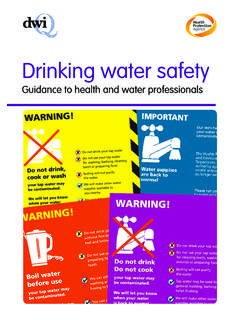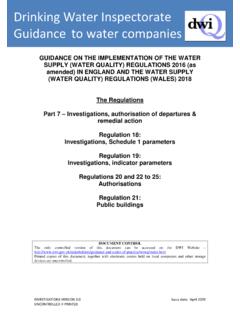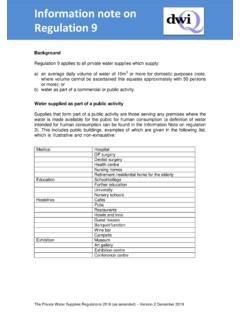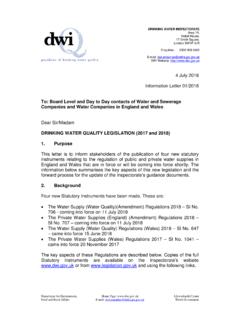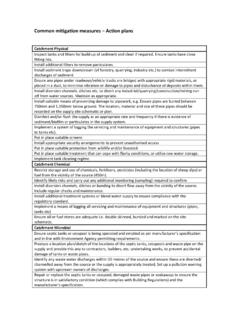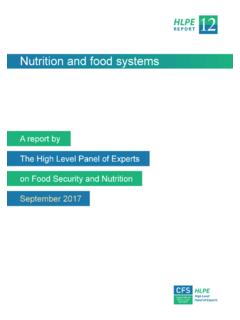Transcription of DRINKING WATER INSPECTORATE
1 DRINKING WATER INSPECTORATE guardians of DRINKING WATER quality A Brief Guide to DRINKING WATER Safety Plans DWI A brief guide to DRINKING WATER safety plans October 2005 Page 1 of 12 Introduction The DRINKING WATER INSPECTORATE strongly supports the World Health Organisation s initiative in promoting WATER safety plans as the most effective means of consistently ensuring the safety of a DRINKING WATER supply. This brief guidance is intended to give an outline of the process of constructing a WATER safety plan and a basic structure for what it should contain. What is a WATER Safety Plan? A WATER Safety Plan (WSP) is the most effective way of ensuring that a WATER supply is safe for human consumption and that it meets the health based standards and other regulatory requirements. It is based on a comprehensive risk assessment and risk management approach to all the steps in a WATER supply chain from catchment to consumer. The primary objectives of a WATER safety plan in protecting human health and ensuring good WATER supply practice are the minimisation of contamination of source waters, the reduction or removal of contamination through appropriate treatment processes and the prevention of contamination in the distribution network and the domestic distribution system.
2 These objectives are applicable to all WATER supply chains, irrespective of their size or complexity. A WSP should ideally be developed for each WATER supply chain. For very small supplies this may be quite challenging and it would be acceptable to use a generic or model WSP for small WATER supply chains that are similar in nature with guidance on application to individual systems. Such generic or model WSPs could be based around a specified packaged technology. However, for all other WATER supply chains a WSP should be developed specifically for each system. Clearly WSPs can vary in complexity depending on the WATER supply chain. Existing good WATER supply management practices form an integral part of WSPs, but they may not include hazard identification and risk assessment and management or be tailored for each specific WATER supply chain. A WSP is essentially a framework of hazard identification, risk assessment, risk management including the control measures, monitoring and incident and emergency plans and the associated documentation for each stage in the WATER supply chain.
3 The WATER supplier is the key player in a WSP but other stakeholders have significant roles. Essentially a WSP has three key components as follows: a system assessment to determine whether the WATER supply chain as a whole can deliver WATER of a quality that meets health-based targets. This system assessment identifies the potential hazards in each part of the WATER supply chain, the level of risk presented by each identified hazard and the appropriate measures to control the identified risks to ensure that the WATER supply is safe, the standards and targets are met and human health is protected; operational monitoring of an appropriate nature and frequency at an appropriate point in the WATER supply chain is defined for each control measure identified and implemented from the system assessment to ensure that any deviation from the required performance is rapidly detected; and DWI A brief guide to DRINKING WATER safety plans October 2005 Page 2 of 12 documentation of management arrangements including details of the system assessment, operational monitoring and validation monitoring together with a description of the actions to be taken in normal operation and incident conditions when there is, or there is a risk of, non-compliance with a standard or target value or failure to meet an operational control, or there is a potential risk to human health.
4 These actions should include appropriate investigations, remedial action in the form of improvement programmes, reporting and communication. These three key components require: a thorough understanding of each element of the specific WATER supply chain and its capability to supply WATER that is safe and meets the health based standards, targets for indicator parameters and other requirements aimed at protecting human health; identification of the hazards for each element of the WATER supply chain, that is the potential sources of contamination and whether they present a risk for that element of the WATER supply chain and an estimate of the degree of risk; identification of the control measures for each identified risk and validation of those control measures; implementation of a system of routine monitoring of those control measures with criteria for triggering action when the control measures are not within the specified targets; implementation of a plan of remedial action when a control measure is not within the specified target with checking that the action has brought the system back under control; validation monitoring to determine whether the system is performing as assumed in the system assessment; and verification by an independent person or organisation that the WSP is being implemented correctly and is ensuring that the WATER supplied is safe and meets health based and other regulatory targets.
5 Guidance on the Preparation of WATER Safety Plans Assembling a team of experts The first task for the preparation of a WSP or a group of WSPs is to assemble an appropriate team of experts with a thorough understanding of each stage of the WATER supply chains involved. This team should include specialists with knowledge of the catchment and raw WATER sources, WATER treatment processes, distribution networks, operations management, DRINKING WATER quality, public health and domestic distribution systems (consumer representative). Many of the team will be drawn from within the WATER supplier but others such as the catchment and public health specialists may be drawn from other organisations. System assessment and design DWI A brief guide to DRINKING WATER safety plans October 2005 Page 3 of 12 The second task is to prepare a flow diagram that documents and describes the system to be used to prepare the WSP. Generally the flow diagram should contain the following elements: Assemble team of experts - to prepare WATER Safety Plan and document the system Hazard assessment identification of the potential hazards at each stage of the WATER supply chain and how the hazard might enter or affect the chain.
6 A flow diagram of the WATER supply chain is essential for this and the following elementsRisk assessment assess the likelihood, that is the level of risk, of each identified hazard entering or affecting the chain and the consequences, that is the severity, of the effect Control measures identify the control measures for each identified risk that it is considered necessary to control because of its level and severity and validate those measures by intensive monitoring and other checks Monitoring of control measures define the routine monitoring system for each control measure, including what is monitored and how frequently and the criteria (limits) of acceptable performance Management procedures prepare management procedures (plans) for action, including communications, investigations and remedial measures, when a control measure fails to meet acceptable performance under normal operating conditions d during incidents/emergencieans Validation monitoring prepare a routine validation monitoring programme, including what is monitored and how frequently, to check that the WSP is working, that system units are working as assumed in the system assessment and the WATER being supplied is safe and meets the health based standards, and other requirementsSupporting programmes develop supporting systems such as quality control, standard operating procedures and training programmes Documentation document all the above elements of the WSP The expert team, or designated individuals within the team, should carry out the steps in the flow diagram and document those steps and the information, conclusions and results of each step thereby preparing the WSP.
7 Once the WSP has been DWI A brief guide to DRINKING WATER safety plans October 2005 Page 4 of 12 prepared it should be put in place as quickly as possible and it should be reviewed from time to time and reviewed immediately if there has been any significant change of circumstances in any part of the WATER supply chain or if there has been a problem with the quality of the WATER supply. The following sections give brief guidance on the preparation and content of WSPs for each element of the WATER supply chain. The guidance is not intended to be fully inclusive and more detailed and comprehensive guidance can be found in the World Health Organisation s Guidelines for DRINKING - WATER Quality, Third Edition, Volume 1, Recommendations and WATER Safety Plans: Protecting DRINKING - WATER Quality from Catchment to Consumers. Catchment and Raw WATER Source Protection It is essential to collect relevant information about the nature of the catchment and the activities taking place in the catchment and about the nature and quality of the raw WATER source as part of a WSP.
8 Examples of the information required are: Catchment geology, hydrology, meteorology and weather patterns nature of the land and it use, in particular degree of urbanisation, industrial activities, animal rearing and arable farming, degree of natural land and its wildlife, quarrying and mining (that is uses and activities that could give rise to contamination of raw WATER sources) competing WATER uses such as irrigation and river compensation flows planned future activities any existing catchment control and protection zones Surface WATER type of WATER such as river (direct abstraction), river (abstraction in storage reservoir), impounding reservoir, lake inventory of point discharges such as sewage effluents, industrial effluents, WATER from mining WATER quality and how it varies seasonally and with weather patterns flow and reliability of source and retention time if stored recreational and other human activity any existing source protection systems Groundwater confined or unconfined aquifer, hydrology and recharge area flow rate, direction of flow and dilution characteristics whether fast or slow response to activities and events on surface depth of casing and abstraction and any wellhead protection inventory of activities in the recharge area that could affect WATER quality Hazard identification The next step in the preparation of a WSP is to identify the hazards that arise in the particular catchment.
9 Some examples of typical hazards are: DWI A brief guide to DRINKING WATER safety plans October 2005 Page 5 of 12 rapid variations in raw WATER quality arising from meteorological effects and activities within the catchment pollution of raw WATER from point discharges such as sewage, septic tank and industrial effluents, storm WATER overflows, overflows from active and closed mines and landfill sites pollution from agricultural activities including chemicals and fertilisers from arable land/forestry and wastes from animal rearing pollution from human recreational activity and wildlife inadequate protection of the source and its point of abstraction short-circuiting, stratification and eutrophication of raw WATER storage reservoirs Risk assessment The next step is to assess the risk associated with each identified hazard. There are two aspects to assessing the risk. The first is the likelihood of the hazard or hazardous event occurring, taking into account existing catchment controls and treatment processes and controls, and it could be described qualitatively in terms such as almost certain, likely, moderately likely, unlikely or rarely or by a quantitative scoring method.
10 The second is the severity of the consequences of the hazard should it occur, particularly the effect on human health and meeting health based standards and indicator parameter values. Again this assessment could be described qualitatively in terms such as catastrophic, major, moderate, minor or insignificant or by a quantitative scoring method. The risk associated with each hazard is a combination of the likelihood of occurrence and the severity of the consequences. The risks can then be ranked in priority for action, but not all will require attention because some will be very small. Control measures The next step is to identify the control measures in the catchment or at the point of abstraction that will reduce or eliminate the risk. It should be noted that some risks cannot in practice be controlled by these measures and can only be controlled by appropriate treatment processes. Examples of typical control measures are: implementing a catchment management plan that includes measures to protect surface and groundwater such as o controls of all point sources of effluent or overflows discharging to the catchment o site specific protection requirements, such as containment for industrial chemicals and agricultural slurries o designation, limitation and control of specific activities or uses with all or part of the catchment o regular inspection of the catchment planning regulations include protection of WATER resources against future activities protection at the point of abstraction such as o security to prevent unauthorised access or tampering by humans or animals o appropriate arrangements for surface WATER abstraction from rivers, reservoirs and lake and for wellhead and casings for groundwater abstraction DWI A brief guide to DRINKING WATER safety plans October 2005 Page 6 of 12 reservoir management to minimise eutrophication.


